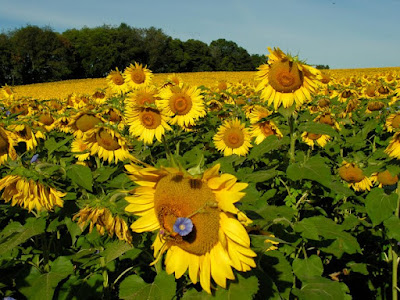
My brother Bill is a true contemplative, can see deeply into nature and appreciate its soul nourishing beauty more than anyone I know. He can step out of the “hurry-up” pace of modern activity to watch the birds, or the movement of the wind in the trees, currents of water in the stream, and enjoys being part of where he is and giving it his full attention. When he pulled over to see the field of sunflowers blooming in bright sunlight, the pleasure was extended by seeing so many other people doing the same thing, pulled to a stop, arrested by beauty, taking pictures to send to their friends. We want to share beauty and the pleasure we take in it. And we have more ways than ever to share things with others. He said the people who had stopped were talking to each other about it. It was an experience that unified strangers. He and I had a wonderful conversation about the power of beauty to demand attention and to bring people together in wonder. It got me to thinking about how we can all be each other’s gurus, sharing whatever makes us feel and think more deeply. People are tired of the superficiality being emphasized by so much media and welcome opportunities for more satisfying life experience.
When we feel pleasure at the sight of sunflowers it’s evidence of the endorphins, our natural opiates reinforcing what’s good for us and combating our pain. Connecting is good for our health, drawing attention out of ourselves and into our surroundings. We begin by connecting to the beauty we see and extend the connection as we share it.
I heard Dr. Herbert Benson on the radio recently discussing his newest book, “Relaxation Revolution”. An enormous part of the body/mind reciprocity is the way we visualize our condition. Diagnosis exacerbates a condition because its definition creates a set of expectations, images of the form the disease will take. He used the phrase, “remembering wellness” for picturing the healthy condition you know from experience, visualizing a time when the problem wasn’t there. He emphasizes the need to do it every day to rework long held negative images. Even more effective might be our memories of moments of connection, people talking about a field of sunflowers. Pain separates us. Remembered experiences of beauty in all of its forms restore our connection and can be used for self-healing.
Images of growth, in particular, fortify our vitality, and are a favored subject for artists and photographers. The process of growth is the experience of extending of ourselves, reaching beyond our previous limits, applying our learning, experience and outlook in our interaction with the physical world. Emerson spoke of the value of work as in, not the results or profit from the work, but the increased power as our skills are developed and improved. As Erich Fromm wrote, “Living is growing” which may be part of why we’re attracted to growth in nature. Images of nature reinforce our participation in cycles of growth and our identification with the life-force that could also be seen as spirit. Dylan Thomas imagined spirit so beautifully as “that force that through the green fuse drives the flower.” Remembering the images that pulled our attention out of ourselves and into the world may be more restorative than we realize.
(Sunflower photo by Bill Waters)
